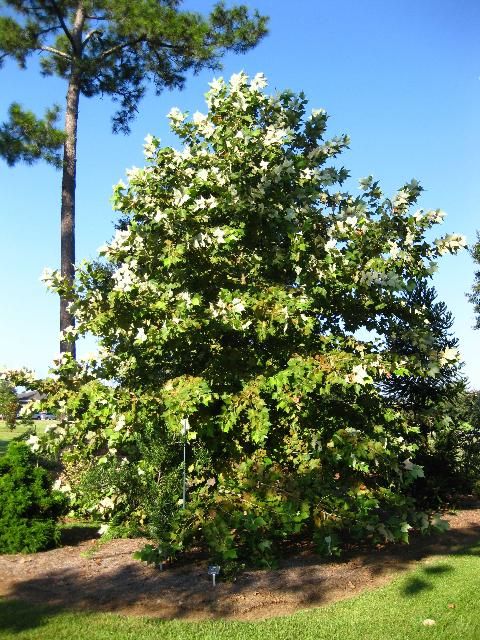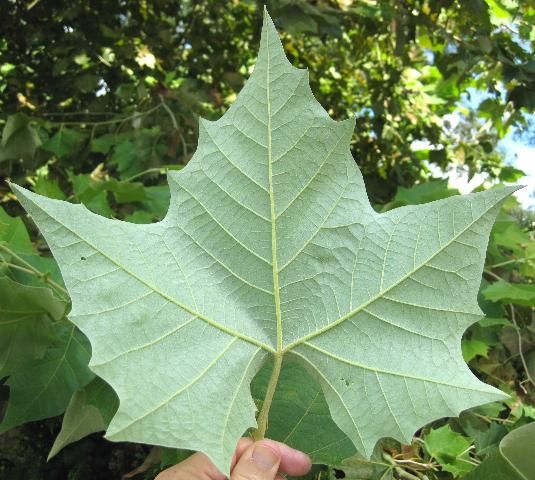Rzedowski's sycamore (Platanus rzedowskii, formerly included with P. mexicana) is a fast-growing, drought-tolerant tree boasting smooth white-and-tan mottled bark and large, maple-like leaves with velvety, silver undersides. Native to northeastern Mexico, Rzedowski's sycamore has long been considered one of the most attractive sycamores and was recently recognized as a species distinct from P. mexicana, Mexican sycamore.

Credit: Gary Knox, UF/IFAS
Rzedowski's sycamore is slightly smaller than our native American sycamore (Platanus occidentalis). While known to grow up to 80 feet or more in the wild, Rzedowski's sycamore typically reaches a mature height of 50 feet in the landscape, with a width of about 30 feet. This tree grows best in full sun and is adapted to most soils, including alkaline soils. While considered drought tolerant, best success occurs when plants are irrigated until established. Cold hardiness of Rzedowski's sycamore is unknown, but it grows well as far north as USDA Cold Hardiness Zone 8b in Texas and Florida.
The lobed, maple-like leaves are up to 8 inches wide and olive green, sometimes turning yellow before falling in December. Leaf undersides of mature trees (at least 4 to 6 years old) develop short, dense, whitish hairs, resulting in an attractive silvery appearance. The large leaves can be a nuisance if they fall where leaves must be raked. Like the American sycamore, the aggressive roots and relatively large mature size of this tree suggest that it should not be used near structures and pavement or under power lines.
Male and female flowers are borne separately on the same plant from December through February and appear as greenish balls hanging from the branches. Fruiting takes place in April through August and is an aggregate-like, ball-shaped fruit about 1 1/2 inches in diameter occurring individually, unlike true P. mexicana, which has racemes of three or more fruits.
Rzedowski's sycamore is resistant to bacterial leaf scorch, which can be a problem on American sycamore. This bacterium causes leaves to curl and turn brown and may eventually kill American sycamore. Two fungal diseases occasionally affecting Rzedowski's sycamore are anthracnose and powdery mildew. Anthracnose causes moderate to severe leaf drop during cool, wet springs. Initial symptoms are light brown areas forming along the veins of new leaves; if severe, anthracnose can cause cankers as well as leaf drop. Powdery mildew appears as a whitish dust on leaves.
Sycamore lace bugs may feed on leaf undersides in late summer and fall. The feeding results in a stippled appearance on the top of the leaf and black spots of feces on the underside. So far, observations of this tree in Florida suggest that infestations of sycamore lace bugs are not as severe as on American sycamore. Aphids may also feed on leaves; they cause little damage to the tree, but they exude honeydew upon which sooty mold grows, turning leaf surfaces black.
Rzedowski's sycamore is an attractive, smaller-statured alternative to American sycamore. Unfortunately, it is not commonly grown and may be difficult to find. Rzedowski's sycamore should be propagated by cuttings to retain its ornamental characteristics. It readily hybridizes with American sycamore, and hybrids grown from seeds are not considered as attractive as true Rzedowski's sycamore.
Platanus rzedowskii (Rzedowski's sycamore) has not yet been evaluated using the UF/IFAS Assessment of Non-Native Plants in Florida's Natural Areas (http://assessment.ifas.ufl.edu). Without this assessment, the temporary conclusion is that P. rzedowskii is not a problem species at this time and may be recommended.

Credit: Gary Knox, UF/IFAS